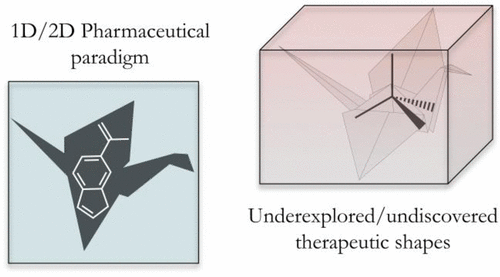当前位置:
X-MOL 学术
›
ACS Med. Chem. Lett.
›
论文详情
Our official English website, www.x-mol.net, welcomes your
feedback! (Note: you will need to create a separate account there.)
Evaluation of 3-Dimensionality in Approved and Experimental Drug Space.
ACS Medicinal Chemistry Letters ( IF 3.5 ) Pub Date : 2020-05-18 , DOI: 10.1021/acsmedchemlett.0c00121 Kathleen E Prosser 1 , Ryjul W Stokes 1 , Seth M Cohen 1
ACS Medicinal Chemistry Letters ( IF 3.5 ) Pub Date : 2020-05-18 , DOI: 10.1021/acsmedchemlett.0c00121 Kathleen E Prosser 1 , Ryjul W Stokes 1 , Seth M Cohen 1
Affiliation

|
The 3-dimensional (3D) structure of therapeutics and other bioactive molecules is an important factor in determining the strength and selectivity of their protein–ligand interactions. Previous efforts have considered the strain introduced and tolerated through conformational changes induced upon protein binding. Herein, we present an analysis of 3-dimentionality for energy-minimized structures from the DrugBank and ligands bound to proteins identified in the Protein Data Bank (PDB). This analysis reveals that the majority of molecules found in both the DrugBank and the PDB tend toward linearity and planarity, with few molecules having highly 3D conformations. Decidedly 3D geometries have been historically difficult to achieve, likely due to the synthetic challenge of making 3D organic molecules, and other considerations, such as adherence to the ‘rule-of-five’. This has resulted in the dominance of planar and/or linear topologies of the molecules described here. Strategies to address the generally flat nature of these data sets are explored, including the use of 3D organic fragments and inorganic scaffolds as a means of accessing privileged 3D space. This work highlights the potential utility of libraries with greater 3D topological diversity so that the importance of molecular shape to biological behavior can be more fully understood in drug discovery campaigns.
中文翻译:

已批准和实验药物空间的三维评估。
治疗剂和其他生物活性分子的 3 维 (3D) 结构是决定其蛋白质-配体相互作用的强度和选择性的重要因素。先前的努力已经考虑了通过蛋白质结合诱导的构象变化引入和耐受的菌株。在此,我们对来自 DrugBank 的能量最小化结构和与蛋白质数据库 (PDB) 中鉴定的蛋白质结合的配体进行了 3 维分析。该分析表明,DrugBank 和 PDB 中发现的大多数分子倾向于线性和平面性,很少有分子具有高度 3D 构象。毫无疑问,3D 几何形状在历史上一直难以实现,这可能是由于制造 3D 有机分子的综合挑战以及其他考虑因素,例如遵守“五规则”。这导致了此处描述的分子的平面和/或线性拓扑的主导地位。探索了解决这些数据集普遍平坦性质的策略,包括使用 3D 有机片段和无机支架作为访问特权 3D 空间的手段。这项工作强调了具有更大 3D 拓扑多样性的库的潜在效用,以便在药物发现活动中可以更充分地理解分子形状对生物行为的重要性。
更新日期:2020-05-18
中文翻译:

已批准和实验药物空间的三维评估。
治疗剂和其他生物活性分子的 3 维 (3D) 结构是决定其蛋白质-配体相互作用的强度和选择性的重要因素。先前的努力已经考虑了通过蛋白质结合诱导的构象变化引入和耐受的菌株。在此,我们对来自 DrugBank 的能量最小化结构和与蛋白质数据库 (PDB) 中鉴定的蛋白质结合的配体进行了 3 维分析。该分析表明,DrugBank 和 PDB 中发现的大多数分子倾向于线性和平面性,很少有分子具有高度 3D 构象。毫无疑问,3D 几何形状在历史上一直难以实现,这可能是由于制造 3D 有机分子的综合挑战以及其他考虑因素,例如遵守“五规则”。这导致了此处描述的分子的平面和/或线性拓扑的主导地位。探索了解决这些数据集普遍平坦性质的策略,包括使用 3D 有机片段和无机支架作为访问特权 3D 空间的手段。这项工作强调了具有更大 3D 拓扑多样性的库的潜在效用,以便在药物发现活动中可以更充分地理解分子形状对生物行为的重要性。











































 京公网安备 11010802027423号
京公网安备 11010802027423号